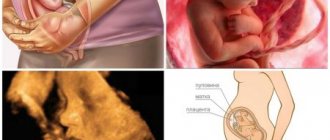Despite the fact that the conventional due date falls on the 40th obstetric week of pregnancy, gestation can be delayed until full 42. This is especially typical for women with a long cycle and irregular periods. There is no need to worry, but you should regularly monitor the baby’s condition, perform CTG and, if necessary, ultrasound of the fetus. The main parameters of pregnancy development at this stage are reflected in the table.
Table - Interesting facts
| Options | Indications |
| Time from conception | 38 weeks |
| Period by month | 40 weeks |
| What month | 9 |
| Child's weight and height | About 48-56 cm and 2500 - 4000 g |
| Location of the uterine fundus | VDM - 36-38 cm |
| Pregnant weight | — From the beginning of pregnancy 10-15 kg; - over the last week 200-300 g |
Hard belly at 38 weeks pregnant
At the thirty-eighth week of pregnancy, various precursors of labor appear, which indicate that the pregnancy will soon be resolved by the birth of a child.
However, before the onset of labor, various phenomena are possible that may alert the expectant mother. Most often, these phenomena are associated with changes in sensations in the abdominal area.
Uterine tone
Throughout the entire period of pregnancy, the tone of the uterus was considered a dangerous phenomenon, but when the 38th week of pregnancy, the stomach will be in good shape in any case, since we are talking about the approaching labor.
In appearance, the tone of the uterus can hardly be confused with some other phenomenon; its characteristic signs are such that the abdomen seems to become stone and harden.
At the same time, the lower back may begin to pull, the whole body seems to be in tension, but very soon this discomfort will pass, but will very quickly return again. However, if such phenomena do not bring particular pain, then we are talking only about so-called training contractions, while the real ones are still ahead.
If at 38 weeks of pregnancy your stomach becomes hard, then it makes sense to say that you will have to go to the maternity hospital in the near future. It is advisable at this time, if possible, to go to the maternity ward in advance if we are talking about childbirth paid for under a contract. Otherwise, you should pack your bag for the maternity hospital so that you are always ready.
What does petrification of the abdomen mean?
In fact, despite the fact that the belly of stone is generally considered to be training contractions, one should not underestimate their effects, since the belly of stone in this case indicates that with each such phenomenon, a softening of the cervix occurs.
Of course, it is too early to talk about the opening, which usually occurs during labor itself, but at 38 weeks of pregnancy, a hard belly indicates that the cervix is preparing for childbirth in this way.
If the expectant mother experiences too much discomfort due to this phenomenon, then it would be advisable to consult a doctor, since this phenomenon can be dangerous for both the expectant mother and the child.
Sometimes gynecologists, to reduce the effect of such spasms, prescribe various drugs, such as no-shpa, which relieve spasms. At the same time, it is useful to lie down more often and not engage in vigorous activity.
Causes of uterine tone in the 3rd trimester
It is completely normal if a woman periodically notices an increase in the tone of the uterus in the third trimester. This suggests that her body is preparing for childbirth. As the period increases, episodes of tension in the muscles of the body of the reproductive organ will occur more often, as a result of which labor contractions will begin.
Other reasons for increased uterine tone in late pregnancy are:
- endocrine diseases (usually begin even before pregnancy) - excessive production of androgens and estrogens, endometriosis, lack of progesterone,
- congenital anatomical abnormalities in the structure of the genital organs,
- myometrial tumors of benign origin,
- pregnancy with more than one child,
- fetus with a large body weight,
- polyhydramnios or oligohydramnios,
- stress and psycho-emotional shocks,
- unfavorable environmental situation,
- bad habits,
- history of abortions and frequent curettages,
- numerous births,
- insufficiency of the cervical canal,
- frequent rough sexual intercourse.
Why does the stomach get hard at 38 weeks of pregnancy?
With the onset of the 38th, “turning point” week, a pregnant woman more often feels a stony belly. By this time, the woman already knows about training contractions, but does not always understand how to recognize them. What can serve as a sign of the beginning of labor, and what should not attract the mother’s attention?
The baby's movements can be painful due to limited space inside.
Mommy's well-being
This period is characterized by the readiness of the baby to be born and the great fatigue of the woman in labor. Now the baby is gaining weight, and the body is actively preparing for the upcoming birth. In total, this leads to increased stress on all body systems. This period is characterized by aching and nagging pain in the back, lower back, and lower abdomen. The skin is stretched to the maximum, which often leads to unpleasant sensations such as peeling and scratching. It can be especially difficult to choose a comfortable sleeping position. Taste preferences change, and appetite may disappear completely.
Uterine tone during pregnancy: symptoms and tips on how to relieve it at home
One of the most common and unpleasant symptoms that every second expectant mother encounters during pregnancy is increased uterine tone, or hypertonicity.
Tone is understood as muscle tension, in which the uterus becomes hard and “stone-like” to the touch, and pulling and aching pain in the lower abdomen appears, often radiating to the lower back.
What is uterine tone
Nature arranges it in such a way that normally the muscles of a pregnant woman’s uterus are in a relaxed state and begin to actively contract only at the time of childbirth, thus preparing for the expulsion of the fetus.
- If the uterus becomes active during pregnancy, long before its end, then this is a pathology that threatens miscarriage, frozen pregnancy or premature birth.
- Tone can appear at different times - at the very beginning of pregnancy, in the middle and at the end, and has many reasons - both hormonal and functional.
Causes of tone
The reason for the tone of the uterus in the early stages of pregnancy is most often a hormonal imbalance of the expectant mother, as a result of which the body’s production of progesterone, the main hormone of pregnancy, which is responsible for its successful course, decreases.
- If an ultrasound shows normal development of the embryo, then in order to maintain the pregnancy, doctors prescribe progesterone medications, antispasmodics and reduced physical activity.
- Progesterone not only reduces the excitability of the uterus, but also helps the proper development of the placenta, protects the fetus from infections, and also has an inhibitory and calming effect on the nervous system so that the pregnant woman is calm and relaxed.
- Typically, progesterone is taken until 16-18 weeks and is discontinued after the final formation of the placenta.
The appearance of tone at 16-17 weeks most likely occurs because the uterus greatly increases in size and begins to put pressure on the cervix, bladder and other organs, as well as cause pain in the back and lower back. In this case, wearing a prenatal bandage is indicated, which will help to evenly distribute the load throughout the abdomen and relieve the load from the spine.
If tone appears sporadically, starting from 34-35 weeks, then these may be “false contractions” or harbingers of labor, which is a completely natural phenomenon, a kind of training for the body before the upcoming birth.
Symptoms and treatment
How to relieve tone at home: useful tips
Despite the fact that in most cases, a toned uterus does not pose a serious threat to the mother and child and does not require treatment, any symptoms of tonus during pregnancy should be under the close supervision of a doctor, so be sure to inform him of any unusual changes in your well-being.
It is often difficult for a woman to correctly assess her condition on her own, so not a single detail should be left without medical attention:
- If the symptoms do not go away with rest, the lower back is pulled, pain in the lower abdomen and unusual discharge appear, you need to be alarmed and see a doctor.
- In addition, always pay attention to the child’s unusual behavior - if he is too restless or, conversely, unusually quiet.
- You also need to see a doctor if irregular cramping pain appears against the background of tone, in order to eliminate the threat of miscarriage.
- The doctor will examine you, listen to the fetal heartbeat, perform an ultrasound if necessary, and prescribe treatment with drugs that relax the muscles of the uterus.
Check your body fat %, BMI and other important parameters
If a medical examination shows a threat of miscarriage and you are asked to go to the hospital, do not refuse - remember that the life and health of the unborn child depends on this, because the hypertonicity of the uterus compresses the blood vessels of the placenta, causing the baby to suffer in utero from a lack of oxygen and nutrients.
- In the second trimester, along with prolonged and painful contractions of the uterus, an ultrasound scan may show shortening of the cervix and a tendency to dilate. In this case, to relieve tone and maintain pregnancy, hospital treatment and strict bed rest are necessary.
- If tone develops in the third trimester, then due to changes in hormonal levels and preparation of the cervix for labor, painless contractions can develop into labor. In this case, urgent medical care in a hospital setting is also necessary.
Timely treatment almost always allows you to prolong pregnancy as long as possible, at least until 34-35 weeks, so that the baby’s lungs are fully formed and he can breathe independently after birth.
How to relieve tone at home: tips and prevention
If ultrasound and regular medical examinations show that the pregnancy is developing without complications, everything is fine with the baby, and the tone is manifested only by mild and irregular spasms and nothing else bothers you, you need to learn how to remove it yourself at any time at home.
- Most often, doctors prescribe no-shpa or suppositories with papaverine to relieve spasms, as well as sedatives based on valerian, hawthorn and motherwort.
- If there is no discharge and labor is still far away, you can take a warm bath, listen to pleasant, calm music or watch a good TV program.
- If you learn to quickly calm down and reduce emotional stress, uterine cramps will go away without taking medications.
It has been noticed that tone most often occurs during the first pregnancy, when the expectant mother worries about every issue due to inexperience. It is very important not to worry or get nervous over trifles, because stress can trigger premature birth even in a completely healthy woman.
Whatever happens, remember that at the moment there is nothing more important than the health of the unborn baby, so remain psychologically calm.
Diet for uterine tone
- Doctors advise pregnant women with uterine tone to include more foods containing magnesium in their diet during pregnancy, because the need for magnesium during pregnancy increases 2-3 times and reaches 400 mg per day.
- This unique microelement not only relaxes the muscles of the uterus, intestines and other internal organs, but also perfectly reduces the hyperexcitability of the nervous system, which is especially important for a pregnant woman.
- Nuts, beans, bran bread, green vegetables, buckwheat and oatmeal contain a lot of magnesium.
- Do not forget to drink at least 2 liters of ordinary water daily to protect yourself from dehydration and constipation, which is dangerous with uterine hypertonicity.
- To prevent constipation and normalize beneficial microflora in the intestines, eat more foods containing fiber and try to train yourself to go to the toilet at the same time.
- Avoid coffee, tea, cola and other diuretic caffeine-containing drinks.
To prevent uterine tone:
- Follow the correct daily routine;
- Avoid excessive physical activity;
- Limit sexual activity;
- Strictly observe intimate hygiene to avoid the occurrence of genitourinary infections (candidiasis (thrush), cystitis, etc.);
- Get more rest - a good night's sleep should be complete, lasting at least 8 hours, it is advisable to take extra sleep or lie down during the day after lunch;
- If you are not prescribed bed rest, take a walk in the fresh air whenever possible and ventilate the room well before going to bed.
Take all medical recommendations responsibly, remain positive and in a good mood - this will help you avoid various complications of pregnancy and give birth to a strong, healthy baby.
(1 , 5,00 out of 5)
Source: https://happy-womens.com/tonus-matki-pri-beremennosti.html
Features of the term
The likelihood that birth will occur at 39 weeks of pregnancy is high. Usually by this time the expectant mother has already prepared everything necessary and is in constant readiness to see her baby. As before, she needs to closely monitor the activity of the fetus and her condition so that, if necessary, she immediately goes to the maternity hospital. Even when leaving home for a short time, it is recommended to have the necessary documents with you in case of an unforeseen situation.
Second pregnancy
With a second pregnancy, the possibility of giving birth at 39 weeks increases.
The second and subsequent births often occur faster than the first, so if contractions appear, you should not postpone a visit to the maternity hospital. Otherwise, the risk of labor occurring outside a medical facility increases.
How does the uterus change at 18 weeks of pregnancy?
The growing uterus shifts the center of gravity and pulls the lower back forward. Ultimately, this state of affairs causes the pregnant woman to experience back and lower back pain.
Uterus size
The size of the uterus at 18 weeks is comparable to the size of a melon. During this period, the uterus can be clearly felt slightly below the navel. In the coming days, the woman may begin to feel the first important movements of the fetus (initially this sensation is comparable to gas bubbles).
Uterus during pregnancy
During pregnancy, the uterus grows upward from the woman's pelvis. The upper part of the uterus may be well felt at 18 weeks of pregnancy, but the doctor can feel it after about 12 weeks of pregnancy.
By the 24th week of pregnancy, the muscles begin to stretch upward, thereby forming the thick upper segment of the uterus. This leaves a thin layer of muscle underneath, known as the inferior segment. The lower segment separates the cervix from the upper segment.
By the 18th week of pregnancy, the uterus continues to grow along with the baby.
The height of the uterine fundus at 18 weeks should be at the level of the navel, and after about two weeks it should rise above it.
After raising the uterus, the pregnant woman's physician will use a tape measure at each examination to measure the height of the uterine fundus at 18 weeks, and determine the distance from the pubic bone to the top of the uterus in centimeters; this number usually corresponds to the number of weeks of pregnancy. Thus, the length will be 30 centimeters when a woman is 30 weeks pregnant, for example.
If your uterus is too large or too small at 18 weeks, your due date may be incorrect, or further tests may be needed to rule out any unusual pregnancy complications. The height of the uterine fundus at 18 weeks is oriented near the navel, and by the time of birth it rises almost to the chest.
After childbirth, the uterus will gradually return to its pre-pregnancy position. This usually takes about six weeks after birth, during which time the uterus has time to return to its pre-pregnancy size and shape. The size of the uterus at 18 weeks, and this is almost the middle, comparable to the size of a melon. The size of the uterus usually reaches its peak at around 36 weeks of pregnancy.
Uterine tone
Tone at the 18th week of pregnancy, as well as throughout pregnancy, is very important. This is due to the fact that the entire further course of pregnancy depends on the uterus. Most often, when people talk about uterine tone, they mean its enlargement or hypertonicity. This unfavorable sign can lead to spontaneous abortion in early pregnancy or premature birth.
Before talking about the tone of the uterus at 18 weeks, you should understand that the largest layer of the uterus is the muscular layer. During pregnancy, these muscles gradually expand as the baby grows and the volume of the uterus increases.
With these feelings, which are new to the body, a woman may realize that something unusual is happening inside her.
Pregnant women usually also feel bloating or distension, and nagging pain in the lower back and abdomen.
The tone at week 18 may be within normal limits, but it may also be increased. Expectant mothers should remember that tension in the uterus is not a disease, but a condition of the uterus through which its muscles contract involuntarily during pregnancy, i.e. before giving birth.
Stress, depression, anxiety and any problems, increased levels of fatigue and short sleep during pregnancy can cause disturbances in the central nervous system and, as a result, this can disrupt the regulation of uterine muscle tone.
Physical activity such as running, jumping, tight-fitting belts, or high-heeled shoes may also cause the uterus to become more toned at 18 weeks.
It is necessary to distinguish between physiological tension of the uterine muscles and non-productive uterine contractions and true contractions, which can cause premature labor.
The tone by the 18th week of pregnancy can only be determined by a doctor after examination and additional tests.
Therefore, if a woman experiences spasmodic pain in the lower abdomen, back, or feels as if amniotic fluid is leaking, then she should seek urgent medical help.
During the examination, the doctor will assess the condition of the fetus and check the uterus at 18 weeks of pregnancy for tone.
If there is no true uterine contraction, the cervix remains long and closed, the spasmodic pain will be considered false and will not lead to premature labor. This condition, toned by week 18, does not require treatment.
The administration of antispasmodic drugs will help interrupt contractions. In such cases, only symptomatic treatment is required. If the contractions are true or the cervix shortens, the doctor will recommend hospitalization.
Tone warning
In order to avoid 18 weeks of pregnancy tone and painful tension in the muscles of the uterus, as well as increased sensitivity of the uterus, pregnant women should follow a proper sleep schedule, rest and completely avoid stress.
Women who work during this period should try not to stay late at work and travel less by public transport, if possible. Uterine tone at 18 weeks can be avoided by taking good care of yourself. Excessive physical activity should be avoided.
Participation in sports during pregnancy is not contraindicated, but specific types of sports, frequency and level of exertion should be agreed with your doctor. To ensure normal tone at 18 weeks, you should wear shoes with heels no higher than 4 cm.
conclusions
If there are any deviations from the norm or pain, a woman should consult a doctor for help. Increased uterine tone can be dangerous for the health of the pregnant woman and her child.
Source: https://www.pinetka.com/beremennost/vse-dlya-beremennyih/kak-izmenyaetsya-matka-na-18-nedele-beremennosti.html
Feel
At the 39th week of pregnancy, the expectant mother experiences a lot of different feelings - from fear of the upcoming birth and accumulated physical fatigue to euphoria from the upcoming meeting with the long-awaited baby.
Towards the end of the gestational period, bearing a child becomes increasingly difficult. The significantly increased total weight and size of the fetus make themselves felt. Some of the baby's movements may cause pain to the mother. By the 39th week, all a woman’s thoughts are focused on one thing - a speedy birth.
Training contractions are already familiar to the pregnant woman and do not cause panic. It is worth remembering, however, that at this stage, cramping pain may be evidence of the beginning of labor. The difference is their greater pain and the appearance of periodicity.
Discharge
Throughout pregnancy, normal discharge from the genital tract is whitish in color and has a homogeneous consistency. The smell is either absent or has a sourish tint. The amount of discharge is scanty or moderate.
A normal occurrence for the 39th week of pregnancy is the release of the mucus plug that previously covered the cervical canal. This can happen several days before birth. A plug is a clot of mucus with streaks of blood embedded in it. Its separation is painless and can occur either simultaneously or in several stages.
At 39 weeks of pregnancy, monitoring the nature of the discharge is very important. A change in color to yellow or green, or the appearance of a foul odor may indicate a bacterial infection. In such cases, the doctor will decide on the possibility of treating the disease and the most appropriate method of delivery. In some cases, preference may be given to the surgical method. The reason for this is the possibility of infection of the fetus as it passes through the mother’s birth canal.
The appearance of bloody discharge from the genital tract is an ominous sign that may indicate the beginning of abruption of a normally located placenta. In this situation, you should immediately contact the obstetric hospital, as the child’s life is at risk.
Tone and the possibility of taking No-Shpa
Often pregnant women complain about the emerging tone of the uterus. They feel as if their stomach is turning to stone. This phenomenon is called training contractions. They are less painful than true ones, and there is no frequency of their occurrence. If they cause significant discomfort to the woman, the doctor monitoring the pregnancy may recommend taking No-shpa. This will help differentiate true contractions from false ones: when labor begins while taking the drug, contractions will continue to occur.
In recent years, in obstetric practice, it has been customary to prescribe No-shpa to prepare for childbirth in the last weeks of pregnancy. Taking it will facilitate the opening and softening of the cervix, ensure relaxation of its smooth muscles, which will help avoid ruptures during childbirth. For the fetus, taking the drug does not pose any danger.
Edema
The size of the uterus at the end of gestation is large. For this reason, blood flow in the body of the expectant mother is significantly hampered. The consequence of this is the appearance of edema. Their most likely localization is the lower limbs and hands. Normally, swelling is mild, appears in the morning or after a long walk and does not cause significant discomfort.
Limiting fluid intake and excluding salty and spicy foods from the diet will help combat it. The use of medications is allowed only after consultation with a doctor.
In a situation where swelling is severe and accompanies the pregnant woman throughout the day, you must immediately inform your doctor about it. Perhaps the appearance of edema is one of the symptoms of late gestosis - a serious complication of pregnancy that requires immediate medical attention.
Thrush
Vaginal candidiasis often occurs in women in late pregnancy. The reason for this is a decrease in the body's immune defense. To eliminate the risk of possible infection of the fetus during childbirth, it is necessary to treat thrush. The choice of drug is made by the doctor, taking into account all the characteristics of the expectant mother’s body. In some cases, antifungal therapy may be prescribed for prevention.
Headache and insomnia
The appearance of a headache at 39 weeks of pregnancy can be due to many reasons:
- late gestosis;
- arterial hypertension;
- decreased blood pressure;
- severe tension in the muscles of the shoulder girdle;
- strong emotional stress;
- infectious diseases of the upper respiratory tract.
If the pain occurs regularly or is severe, the woman should inform her doctor about it. He will help you find out the cause and select the optimal treatment.
In cases where headaches occur rarely, you can fight them with the help of certain recommendations.
- Hiking in the fresh air should become an integral part of every day for the expectant mother.
- Maintaining a sleep and rest schedule.
- Avoiding stressful situations.
- If pain occurs, applying a cool compress to the back of the head or massaging the temporal areas will help get rid of it or reduce its severity.
- If your blood pressure is low, you can get rid of headaches with a cup of natural coffee.
In case of increased blood pressure and headache, you should immediately consult a doctor.
Insomnia is the scourge of most pregnant women. It can bother a woman throughout pregnancy, reaching its peak at 39 weeks. The causes of this condition are:
- hormonal changes;
- emotional lability;
- physical discomfort.
All of them are especially pronounced in the last weeks of pregnancy. A woman experiences anxiety before the upcoming birth, she is worried about heartburn, frequent urination, and back pain. The belly, which has acquired an impressive size, makes it difficult to choose a comfortable position for sleeping. Training contractions, which often occur at night, also interfere with healthy sleep.
Daily walks, avoiding daytime naps, eating no more than three hours before bedtime, and a warm bath immediately before resting at night can help make it easier to fall asleep and improve the quality of sleep.
Woman's feelings
Active changes occur in the uterus in order for the baby to successfully overcome the birth canal. Often, at the 38th week of pregnancy, women note that the stomach becomes stone while walking, when stroking, or with anxiety.
Cervix
The cervix softens and shortens. In addition, a partial opening of the cervical canal occurs. Now the fundus of the uterus is located at a distance of 18 cm from the navel, and 36-38 cm from the pubis. It descends more and more intensely, and the fetal head tends downward more and more - the baby is pressed against the exit from the pelvic cavity. During examination, the following parameters indicate readiness for childbirth:
- cervix - length 2 cm or less, soft consistency;
- cervical canal - passable for two transverse fingers (2-3 cm), the internal pharynx is softened and pliable;
- discharge - at 38 weeks of pregnancy it should be mucous and free of foreign impurities.
With this condition of the birth canal, if necessary, it is possible to stimulate the woman through amniotomy - opening the membranes and releasing amniotic fluid. If one of the parameters does not correspond, labor induction begins with the vaginal introduction of gels, the installation of special cervical catheters, or the use of medications to ripen the cervix. If there are no indications for early delivery, the woman is given time for physiological preparation.
If labor does not occur from conception at the 38th week of pregnancy, and according to the results of the examination, there is no proper preparation of the birth canal, then the following can help:
- therapeutic exercises - can be replaced by cleaning the house or “walking” the stairs if the woman is in the hospital;
- sex - a man’s sperm contains a large amount of prostaglandins, which have a positive effect on the cervix, promoting its ripening;
- physiotherapy - acupuncture, stimulation with the DENS (DENAS) apparatus can also speed up preparation for childbirth.
Other changes
The muscles become more elastic, and the ligaments of the pelvic bones gradually stretch. During this period, women’s psycho-emotional state usually changes, which is characterized by:
- sudden change in mood;
- increased irritability;
- suspiciousness;
- insomnia or restless sleep.
Also for the expectant mother:
- The size of the foot may change due to swelling;
- pigment spots or moles appear on the body, which will disappear over time after the baby is born;
- the sense of smell is heightened - this is how the body tries to protect the woman from unwanted food;
- urination becomes more frequent due to fetal pressure on the pelvis;
- hemorrhoids become inflamed - sometimes;
- varicose veins appear - in this case, you cannot spend a lot of time in one position, but it is also prohibited to increase the load on your legs;
- Colostrum may be released from the breast - within three days after the birth of the baby it will be replaced by breast milk.
Pain
During this period, the woman feels awkward. The size of the abdomen makes movement much more difficult. The expectant mother may experience pain associated with preparation for childbirth:
- in the perineum - caused by the pressure of the fetus on the pelvic bones;
- in the sacrum - including when the sciatic nerve is pinched;
- in the extremities - due to numbness of the arms and legs due to changes in blood circulation, as well as swelling.
Painful sensations from an often “stony” abdomen, from constipation and exacerbation of hemorrhoids are also possible.
With an exacerbation of ailments to which the expectant mother’s body is predisposed (especially with an increase in temperature), the birth process may accelerate. For example, with acute pyelonephritis, as well as with acute respiratory viral infections and influenza.
Harbingers of childbirth
Shortly before giving birth, a pregnant woman may experience one or more conditions that indicate an approaching meeting with the baby. The most common are:
- nagging pain in the lower abdomen;
- increased frequency of training contractions;
- decreased fetal activity;
- loose stool;
- discharge of the mucus plug;
- weakness, irritability;
- drowsiness.
Nausea and diarrhea
At week 39, some pregnant women complain of nausea and diarrhea. Their occurrence is associated with physiological reasons. Nausea occurs in response to an increase in the level of prostaglandins in the blood, which are necessary for the softening and opening of the cervix. Loose stools are a consequence of increased fetal pressure on the intestines.
However, other causes, such as poisoning, cannot be ruled out. To make sure that the health of the expectant mother and baby is not in danger, if such symptoms occur, she should seek medical help.
Water leakage
The appearance of colorless, watery discharge may indicate leakage of amniotic fluid. Since their quantity can be very scarce, the expectant mother may not pay attention to them for a long time. If you suspect a leak, you can purchase a special test at the pharmacy. It will help determine whether the discharge is actually amniotic fluid.
If the water turns greenish, seek medical help immediately. This sign indicates the onset of fetal hypoxia.
Pain in the lower abdomen and lower back
By the end of the gestational period, most women experience pain in the lower abdomen and lumbar region. The reason for this is a change in hormonal levels before childbirth. The cervix softens, smoothes and prepares to open, the pelvic bones diverge. After childbirth, these sensations will pass without a trace.
Possibility of accelerating labor
Often by the 39th week of pregnancy, a woman’s fatigue reaches its limit. It is natural that she begins to dream about the onset of childbirth almost constantly. Certain recommendations can help bring them somewhat closer.
- Increasing physical activity (climbing stairs, long walks).
- Unprotected sexual contact.
- Stimulation of nipples and areola area.
- Eating foods rich in polyunsaturated fatty acids.
Taking medications to induce labor should only be done on the recommendation of a doctor.
Recommendations
To alleviate the condition and prepare for childbirth, you should follow the recommendations at 38 weeks of pregnancy:
- massage the nipples with a rough towel so that breastfeeding does not bring painful sensations;
- wear a special support bra and bandage;
- It is necessary to prevent stretch marks in advance, preferably from the moment the stomach begins to grow rapidly. It is necessary to use oil and moisturizing creams; this will not completely prevent their appearance if there is a predisposition, but it will help soften and reduce the area of spread;
- read specialized literature to know the basic rules of caring for your baby;
- It is also necessary to choose a maternity hospital in advance and it is advisable to go to hospital a few days before the expected date in order to receive qualified help in a timely manner;
- spend enough time outdoors;
- get a good night's sleep, it is advisable to follow a daily routine;
- eliminate stress;
- Kegel exercises are effective, they promote the elasticity of the vaginal muscles and perfectly prepare the body for childbirth.
The supervising doctor can give some additional recommendations.
An important component is the psychological state of the woman. Many people are afraid of the birth itself, are anxious about the arrival of a new family member and are afraid of not being able to cope with the child. If such thoughts occur frequently and frighten the expectant mother, it is better to contact a full-time psychologist; he should be in any antenatal clinic or city hospital.
The 38th week of pregnancy is a matter of hours, days and weeks before giving birth. The child is already ready for independent life and is fully formed; if he appears at exactly this time, then this is quite normal and natural. The expectant mother must be prepared: prepare her bag, documents and choose a maternity hospital.
The uterus is toned at 38 weeks of pregnancy: preparing for childbirth
Characteristics of the fetus at this stage
It is known that the 38th week of pregnancy is the period from which labor pains are highly likely to develop. By this time, the weight of the child developing in the womb can reach three kilograms. Such a “chubby” baby still continues to grow, increasing his own weight by thirty grams every day. The growth of the fetus at the 38th week is also significant, up to forty-seven centimeters. At this time, a small amount of fluff disappears from the baby’s body.
The last weeks of pregnancy are characterized by the appearance of marigolds in the fetus that can scratch. All these changes indicate the baby’s readiness to be born in the near future.
“Mom’s tummy” also changes by this time, descending into the lower abdominal zone. At the same time, a woman can constantly feel some tension in this area, which is often mistaken for labor pains.
However, the 38th week of pregnancy is not always the last stage of gestation. It is not uncommon for babies to be born at the forty-second week, although the tone of the uterus was felt at 38. This phenomenon is quite common during pregnancy. The reason for the transition of the uterus from a state of “calm” to a state of “tone” is the formation in the body of oxytocin molecules, necessary for normal labor.
Sometimes at 38 weeks of pregnancy, many mothers notice passivity in the movements of their baby. This is due to the fact that by this time babies already know how to sleep and often remain in this state. Therefore, panic on the mother’s part is unacceptable here. If the baby does not move in the mother’s abdominal cavity for a long time, it is worth contacting a doctor who will prescribe the appropriate procedures to find out the reasons for this.
In general, by this time the baby has:
- normal weight;
- formed organism;
- full growth.
By the 38th week of pregnancy, some changes occur in the structure of the expectant mother’s organs. To identify such changes, ultrasound is no longer prescribed, but only in extreme cases.
The well-being of the expectant mother at this time is characterized by:
- preparation for childbirth;
- the appearance of prenatal contractions;
- aging of the placenta;
- development of false spasms.
At this stage of pregnancy, a woman needs to rest as much as possible, mainly in a supine position. In this case, it is necessary to exclude any physical labor, as it can stimulate the development of contractions. Nausea often appears in this trimester, which indicates late toxicosis.
Very often, the last weeks of bearing a baby occur with an increase in blood pressure in the female body. This condition can persist for a long time.
To preserve your own health and the health of your baby, you should go to the maternity hospital, where you will be monitored. This measure will reduce the risk of undesirable consequences for the mother’s body and baby.
The tone of the uterus in the last stage of bearing a child increases, as this stimulates the onset of the approaching labor. At the same time, the urge to urinate becomes more frequent, as the baby puts some pressure on the bladder area. Some women experience pain in the lower back and sacrum with uterine tone.
The last days for the expectant mother may be accompanied by the appearance of slight bleeding. If they are discharged abundantly, indicating the tone of the uterus, there is a high probability of labor occurring.
A 100% sign of the onset of labor is:
- separation of the mucus plug;
- leakage of amniotic fluid.
During this period, the expectant mother should take a greater degree of responsibility towards her own body and her feelings. It is advisable by this time to collect everything necessary for the maternity hospital, since at any moment the need to go there may arise.
We recommend reading:
matka03.ru
Symptoms of uterine tone in the 3rd trimester
Women talk about the tone of the uterus during pregnancy, and that symptoms in the 3rd trimester are especially pronounced. There is a simple explanation for this. After 28 weeks, the volume of the abdomen begins to increase rapidly. During this period, the child is already fully formed and continues to grow. Over the next 10-12 weeks, the embryo will gain subcutaneous fat. The rapid increase in the tummy gives the impression that signs of uterine tone in the third trimester are especially pronounced.
At this stage, the expectant mother is already preparing for the long-awaited meeting with the baby. For this reason, a woman perceives everything that happens to her especially acutely. Often, women in labor go to the maternity hospital and talk about the beginning of labor, but later it turns out that they only have hypertonicity.
You can distinguish the tone of the uterus in the 3rd trimester by the following signs:
- a feeling of pressure is present in the pelvis, radiates to the perineum or sacrum,
- vaginal discharge increases, and in some cases the mucus plug comes off,
- the entire abdomen becomes hard, outwardly it changes its shape - it stretches and rises,
- difficulty breathing,
- there is nagging pain in the lumbar area,
- pulse and heart rate increase.
Intuitively, a woman with spasm of the reproductive organ begins to breathe more often. Therefore, increased breathing and increased blood pressure may be an indirect sign of hypertension.
Strong uterine tone at 38 weeks of pregnancy. Uterus during pregnancy. JabuduMamoj.ru
Precursors of childbirth at the 38th week of pregnancy From the 37th to the 40th week, the baby is considered full-term, and childbirth, as well as its precursors, i.e. phenomena that one way or another indicate an imminent delivery may appear at any time during this period. 38 week harbingers of childbirth are more of a normal course of events than a surprise, and every woman needs to be prepared for this. Another thing is that for a woman giving birth again, the harbingers may even turn out to be childbirth. Childbirth at 38 weeks is, firstly, absolutely normal, and, secondly, for women who are not giving birth for the first time, the sensations are slightly blurred and not so clearly expressed. Whereas first-time women may take it as a harbinger of a malfunction in the body. Lascana - lingerie store
What is increased uterine tone?
To answer this question, let's first figure out what kind of organ it is. The uterus is a hollow, contractile, muscular organ, the basis of which is the myometrium. Naturally, the uterus enlarges during pregnancy. At the same time, each muscle fiber lengthens 10-12 times and thickens 4-5 times. Nature has arranged it so that normally, for 9 months, the muscles of the uterus are in a calm (relaxed) state. This allows you to carry the child to term. Also, normally, the uterus contracts slightly at times; this happens closer to the expected date of birth. Such contractions - contractions - are called training. This is like a dress rehearsal before the main event - the birth of a baby. But it happens that during a long period of pregnancy (in some cases, throughout the entire gestation period), the muscles of the uterus are in an excited, contracted state. The muscle layer of this organ contracts (its tone increases) - the pressure in the uterine cavity increases. Unfortunately, this is a pathological condition that requires appropriate and timely treatment, since it is a symptom of a threatened miscarriage or premature birth.
What is your belly like now?
As mentioned earlier, in the last few months, each woman’s stomach hardens differently. All that remains is to wait for real contractions, since such a phenomenon is one of the signs of the approaching process of giving birth to a baby. Expectations for this moment intensify every day, this is understandable, the belly becomes huge, it is very difficult for mom to move, and sometimes it’s not even easy to put on shoes on your own. For some, the skin itches and peels; such symptoms are not a sign of a disease, just stretch marks make themselves felt. In general, my mother’s belly began to look very strange, sometimes it became disproportionate, the navel turned outward, and the pigment strip appeared more and more clearly.
There is only one piece of advice here: be patient and be extremely careful. Everything will return to its former form upon completion of childbirth, or a short time after it.











